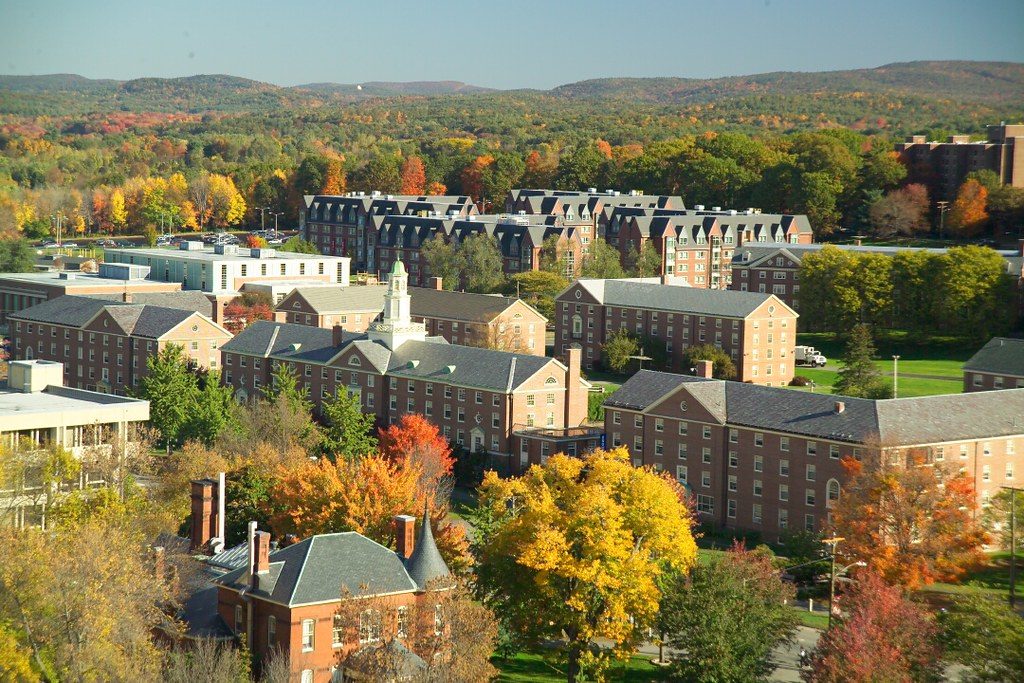Opinion: Recent Deal With UMass A Good Start. Now Keep It Up!

UMass. Amherst dormitories. Photo: flckr.com.

The deal recently announced between UMass and the town of Amherst is a promising start, and the University and the Town deserve credit for coming to it.
However, when viewed in the context of what other institutions pay in lieu of taxes to support to their home towns, UMass is still playing catch-up. Even by the standards of UMass state-wide, we are lagging behind. For example: Lowell, MA now has a population of around 114,000. UMass Lowell has about 18,000 students. UMass Lowell remits $1M/year to Lowell. In the 2020 census, Amherst had a permanent resident population of around 16 ,000. UMass had around 22,000 students, and Amherst College about 2000. (Exact numbers are elusive. The Town Clerk determines the permanent population by subtracting enrolled College and University students from the census figure. However, commuters to UMass aren’t clearly identified by the town or UMass, nor are part-timers just taking a class or two, or some grad students).
UMass has committed to remit $1.025M to the town annually for the next 5 years, plus a one-time purchase of an ambulance, and fees for a pedestrian study to avoid additional fatalities on a town road that bisects campus, and payments to the Amherst schools for students residing in UMass tax-exempt properties. Regardless of the exact numbers, it takes little imagination to see that students at UMass Amherst have a much larger impact on Amherst than UMass Lowell students have on Lowell in terms of its use of emergency services, roads and streets, and, above all, the housing market.
It is worth noting that many private institutions remit much larger PILOTS (payments in lieu of taxes) than public universities. Amherst College is one of the nation’s highest-endowed colleges, and pays its president around half a million dollars per year. The College does give Amherst money, and its students are largely self-contained, but there is ample room for improvement. It is also notable that the town of Amherst is one of the smallest communities in the U.S. to host a flagship campus.
There are several areas where UMass could enhance the town/gown relationship.
UMass disciplinary procedures could apply to off-campus students, if there was better communication between the Amherst Police and the campus, and a willingness at UMass to censure or expel offenders living off-campus.
UMass could not simply buy the town an ambulance, it could have its own ambulance and EMT crew. On party weekends at UMass, the town’s permanent residents effectively ‘get in line’ with intoxicated students needing an ambulance run to the hospital. Whether the town or UMass pays for the ambulance is less relevant; it is the staffing, maintenance and availability of ambulances that are also crucial to ensuring the safety of residents.
On many technical issues, UMass could help Amherst via collaborations and/or student interns working on projects directly impacting the town. Examples: Amherst used to have a website devoted to marking the location of ‘nuisance properties’. Unfortunately, it has been broken for years. UMass has a nationally recognized program in computer sciences. The town desperately needs a system for tracking student rentals and development, and partnering with UMass to rebuild a system searchable by the public would be a win-win, giving students a chance to work on real-world problems directly affecting them. Parameters could include not just ‘where the parties are’. It could include information on the owners of these properties, whether they are Amherst residents with an investment property or two, or LLC’s and investment firms, as well as the physical condition of the properties and the rents charged. This would help neighbors reporting issues to the town, and renters – students and non-students – seeking to compare rental properties. The Engineering Department could assist in evaluating and improving town infrastructure, especially the roads. The Stockbridge School could assist in surveying and maintaining town conservation and water shed areas, etc., etc..
Finally, promoting the health and safety (and ultimately, the viability) of Amherst’s neighborhoods would best be served if the University took more responsibility for housing its students. It is true that the University has recently demolished and replaced apartment housing for graduate students with families, and another complex housing grad and undergrad students was similarly leveled and replaced, with town houses. However, dorms are the most environmentally friendly and least socially disruptive solution to community housing. By neglecting to build them, or partnering to do so, the University outsourced its student housing needs to the town. What has resulted is a gold rush by investors seeking to cash in by converting single family houses into student rentals that garner $1000+ per bedroom. This has led to the town’s resident population decreasing in the past decade as single-family houses are converted to student rentals, reducing the number of people using the library and school systems, even as ‘pro-growth’ advocates push expensive renovations and construction. It has also resulted in more traffic, more complaints about noise, behavior and dilapidated properties, and much less affordable workforce housing. It is not a problem the town can duplex or triplex away without ruining the character of all but the toniest neighborhoods, and even those folks will be dealing with a town center that is being converted into a food court, bars, and out-of-place apartments for students .
Town Manager Bockelman and UMass have struck a good initial deal for the town. But the town is suffering from off-campus misbehavior, potholed roads, and a punishing real estate market increasingly dominated by insouciant landlords. The door to change has opened, and Amherst’s residents must hope the dialogue about fairness continues, with adequate, creative solutions.
John Varner is a resident of District 3.

Yale University announced this week that they will contribute $135 million over the next six years (or a little over $22 million/year ) to the city of New Haven.
https://news.yale.edu/2021/11/17/new-140-million-yale-pledge-yale-new-haven-promote-growth-economy#:~:text=Taken%20together%2C%20Yale's%20payments%20to,amount%20to%20approximately%20%24135.4%20million.&text=These%20voluntary%20payments%20usher%20in%20a%20new%20era%20for%20New%20Haven.
Our town has fared poorly in garnering financial support (in lieu of tax payments) from the educational institutions that call Amherst home.
https://www.amherstindy.org/2023/06/09/issues-analyses-other-northeast-college-towns-receive-much-larger-pilot-payments-than-amherst/
The new agreement with UMass is indeed a good start but raises questions about annual PILOT payments from Amherst College. What would be a reasonable contribution from an institution as wealthy as Amherst College but which does not have the same sized impact on the town as the large university? And is anyone in town government engaged with the college in discussion of current and future PILOT payments?